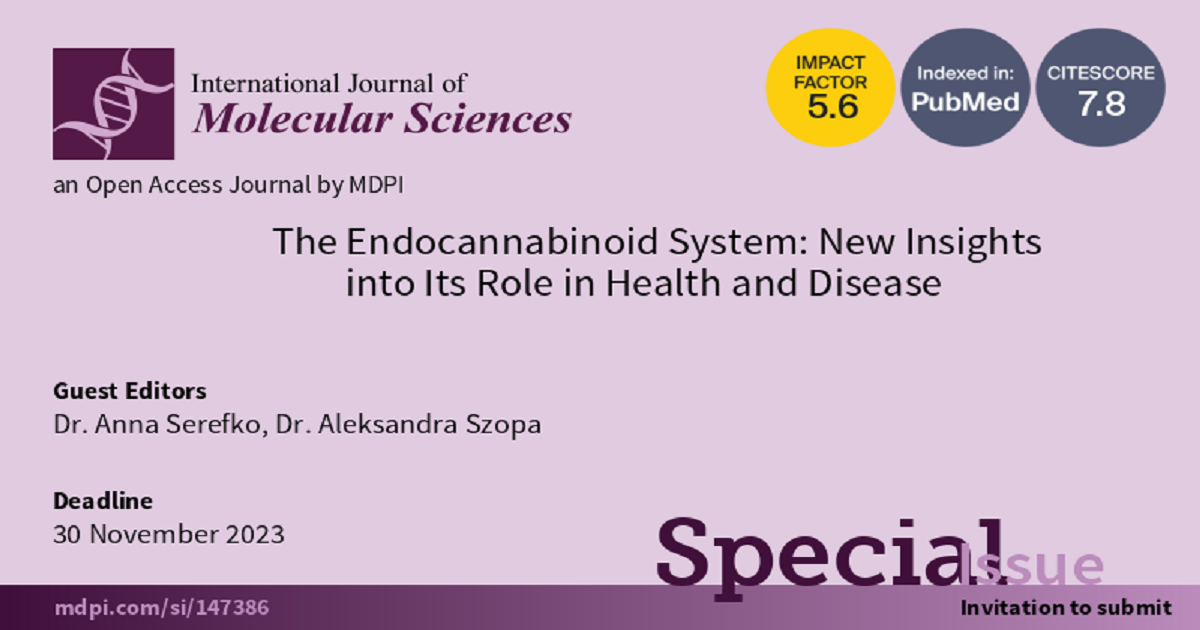- 4.9Impact Factor
- 9.0CiteScore
- 21 daysTime to First Decision
The Endocannabinoid System: New Insights into Its Role in Health and Disease
This special issue belongs to the section “Molecular Pathology, Diagnostics, and Therapeutics“.
Special Issue Information
Dear Colleagues,
Over the last three decades, the endocannabinoid system has emerged as an important neuromodulatory system in the human body that modulates and controls a range of crucial physiological or psychological functions, including inflammatory and immune responses, emotions, learning and memory, sleep, appetite, nociception, as well as cell growth and proliferation. Based on the available data, it seems that specific cannabinoid receptors as well as enzymes responsible for the synthesis and degradation of their endogenous ligands (i.e., endocannabinoids) are promising as therapeutic targets in multiple diseases and disorders. In fact, the hemp plant (Cannabis sativa) that modulates the endocannabinoid system was widely used in the past for its curative properties. Extensive research on compounds targeting components of the endocannabinoid system in relation to the treatment of psychiatric disorders, neurodegenerative diseases, seizures, cancer, pain, metabolic diseases, cardiovascular diseases, and respiratory disorders has been carried out with varying degrees of success. Few drugs have reached the pharmaceutical market, but there are several drug candidates whose activity and safety have been verified. In our Special Issue entitled The Endocannabinoid System: New Insights into Its Role in Health and Disease, we would like to encourage scientists to share their opinions and suggestions related to new therapeutic or diagnostic approaches that affect the endocannabinoid system.
This Special Issue aims to provide a platform for molecular mechanistic research on the endocannabinoid system, with a special focus on its role in health and disease. We warmly welcome your submissions of original papers and reviews based on results from molecular viewpoints.
Dr. Anna Serefko
Dr. Aleksandra Szopa
Guest Editors
Manuscript Submission Information
Manuscripts should be submitted online at www.mdpi.com by registering and logging in to this website. Once you are registered, click here to go to the submission form. Manuscripts can be submitted until the deadline. All submissions that pass pre-check are peer-reviewed. Accepted papers will be published continuously in the journal (as soon as accepted) and will be listed together on the special issue website. Research articles, review articles as well as short communications are invited. For planned papers, a title and short abstract (about 250 words) can be sent to the Editorial Office for assessment.
Submitted manuscripts should not have been published previously, nor be under consideration for publication elsewhere (except conference proceedings papers). All manuscripts are thoroughly refereed through a single-blind peer-review process. A guide for authors and other relevant information for submission of manuscripts is available on the Instructions for Authors page. International Journal of Molecular Sciences is an international peer-reviewed open access semimonthly journal published by MDPI.
Please visit the Instructions for Authors page before submitting a manuscript. There is an Article Processing Charge (APC) for publication in this open access journal. For details about the APC please see here. Submitted papers should be well formatted and use good English. Authors may use MDPI's English editing service prior to publication or during author revisions.
Keywords
- cannabinoids
- cannabinoid receptors
- drug development
- diagnostics
- phytocannabinoids
- synthetic cannabinoids

Benefits of Publishing in a Special Issue
- Ease of navigation: Grouping papers by topic helps scholars navigate broad scope journals more efficiently.
- Greater discoverability: Special Issues support the reach and impact of scientific research. Articles in Special Issues are more discoverable and cited more frequently.
- Expansion of research network: Special Issues facilitate connections among authors, fostering scientific collaborations.
- External promotion: Articles in Special Issues are often promoted through the journal's social media, increasing their visibility.
- e-Book format: Special Issues with more than 10 articles can be published as dedicated e-books, ensuring wide and rapid dissemination.

